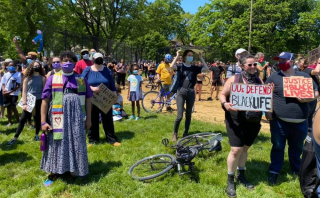Advertisement

Chicago-area UUs gather for a June 6 Black Lives Matter march. (Courtesy Second Unitarian Church of Chicago)
In the wake of June 2020’s antiracism uprisings, communities and congregations across the United States continue to grapple with how best to address racial injustice and engage in the ongoing movement to end it.
While the answer to that question differs for everyone asking, there are common tenets ministers at two Unitarian Universalist congregations active in antiracism work—the Rev. Gretchen Haley at Foothills Unitarian in Fort Collins, Colorado, and the Rev. Jason Lydon at Second Unitarian Church of Chicago—say can serve as guidelines for UU communities committed to “harnessing love’s power to stop oppression” within congregations and out in the streets.
Don’t start your own thing
Haley, who works closely with local leaders such as Johanna Ulloa Girón of the BIPOC (Black, Indigenous, and People of Color) Alliance of Larimer County, urges congregations to look for ways to leverage resources—institutional and personal—to support work already occurring in the community. “Conversations are happening, and they’ve been going on for years, decades even,” Haley says. “The church has resources. How can we hand them off, offer what we have on behalf of the movement?”
Second Unitarian, for example, opened its West Barry Avenue sanctuary to protesters taking to Chicago’s streets demanding justice for George Floyd, Ahmaud Arbery, Breonna Taylor, David McAtee, and Tony McDade, among others. “It was posted all over social media that if folks needed a place to get to, to get away from police violence, or just to get out of the streets after curfew, come find refuge at our church,” says Lydon, before sharing how that decision, in turn, strengthened Second Unitarian’s relationship with its neighbors in the Greater Lakeview area. “They know this is a space in solidarity with them.”
Build trust and intentional partnerships
Both ministers agree that “showing up beyond the headlines” is critical to building authentic relationships that further lasting antiracism work. Long before the most recent spotlight on police violence, Haley and her congregation were in partnership with BIPOC-led organizations working on issues pertinent to Fort Collins’s communities of color, including immigration and fair housing.
However, cautions Ulloa Girón, congregations should be careful to not only show up in times of crisis. “We don’t do that to our friends,” she says. “We don’t just show up when grandma dies. We show up for celebrations, birthdays. We join with them in their everyday lives. When we do that, we realize how much the other person has to offer: Johanna is not just a person who needs saving all the time; she has this knowledge and this ancestry. When you come with a savior mentality, the relationship will forever be imbalanced.”
Know that antiracism work is a lifelong commitment
“The urgency of this work doesn’t go simply because it’s no longer in the news,” Lydon says. “Our services every single Sunday attend to the reality of the world around us. Police violence is something we will pray about every single Sunday.”
Haley emphasizes the importance of recognizing that people in the very same congregation can be in very different places in their lived experience and in their personal growth around racial justice and intercultural competency. While some parishioners might be experiencing racism directly and some might be actively practicing antiracism, others might be recently awaking to the realities of white supremacy or in the process of grieving for BIPOC communities. The way to keep antiracism at the forefront of primarily white, upper-middle-class organizations, says Haley, is to make sure white people stay in relationship with the people of color around them “who have different experiences, to feel that sense of deep urgency, grounded in love with a deep sense of responsibility so that ‘the news’ becomes ‘family.’ It’s a matter of faith. . . . How do we wake up to our Universalist faith and stay present and committed to that?”
Decenter whiteness
“Stop preaching the ‘Coming to Realization about Whiteness’ sermon,” Lydon says. “We’re done with that. We need to ensure that we’re preaching differently, that we’re lifting and amplifying voices of color, so that everyone who hears our antiracism messages feels included and seen. That can’t happen if you’re focused on whiteness.”
But it’s not enough to amplify voices; you need to actively listen to what they’re saying, too, says Ulloa Girón. “When people are in helping mode, they listen for like five seconds and immediately they tell you: ‘This is what we think you should do. These are the people that I know’ . . . which, per se, is not a bad thing, but when we’re talking about power, that leaves us without any.” Instead, Ulloa Girón invites congregations to listen with an ear toward power analysis, or looking at who holds the power in a given situation, how it’s been yielded, and whether its use is equally beneficial to all involved, training people to see what they’ve been indoctrinated from birth not to see.
UUA Organizing Strategy Director Ashley Horan recommends these starting points for training and further resources: